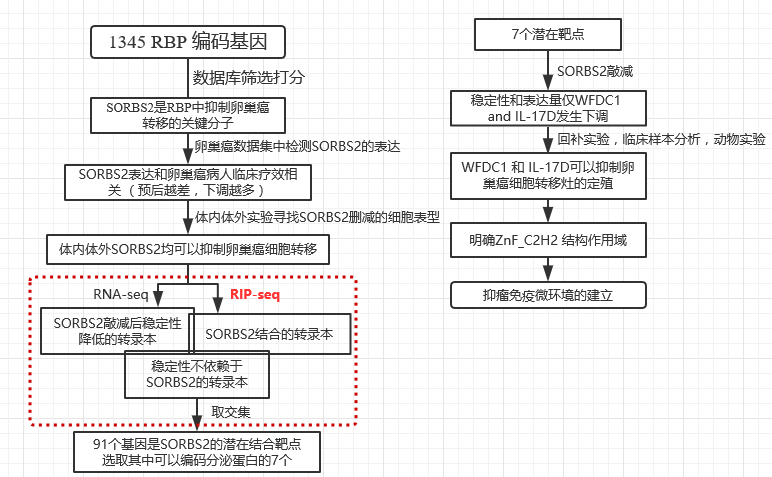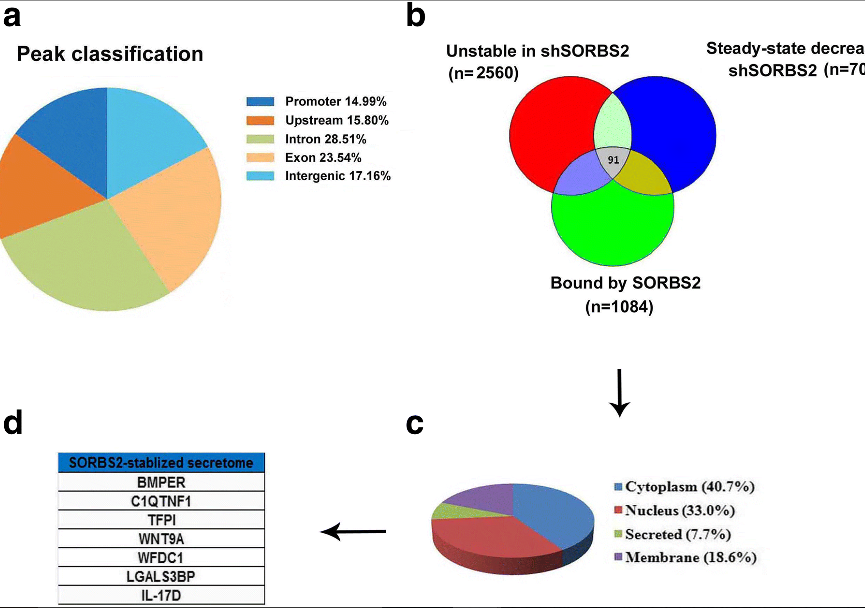As a leader in the field of circular RNA and RNA methylation, Yunxu Bio has been reported in the past month. In the field of RNA methylation, the cloud sequence m6ARNA methylation sequencing service assisted Shanghai Jiaotong University Yu Jianxiu Group to publish the first domestic 10+ RNA methylation article ("Nucleic Acid Research", IF: 10.162); The cloud sequence circular RNA sequencing service has helped many of the world's first articles, including: the world's first mouse brain traumatic exosomes circular RNA research, the world's first Xenopus latiform RNA research, the world's first Circular RNA study of lupus erythematosus (Cell, ed. 6.329).
Recently, another exclusive cloud product: RIP-Seq has helped Huaxi Medical College to publish 12 top journals. The team of Zhou Shengtao of Sichuan University used RIP sequencing to analyze the mechanism of RNA binding protein SORBS2 in ovarian cancer cell metastasis, which provided an important basis for the targeted therapy of ovarian cancer. The subject is novel and very useful.
Research Background:
Ovarian cancer is a gynecological malignant tumor with a high mortality rate. Since the molecular mechanism mediating the development of the disease has not been clearly elucidated, the therapeutic and diagnostic effects against the disease have been unsatisfactory. In addition, whether post-transcriptional regulation of RBP (RNA binding protein)-based mRNA is associated with ovarian cancer and immune function remains uncertain. In the current database (cBioPortal TCGA, AOCS, etc.), SORBS2 (Sorbin and SH3 domain containing 2) was identified as a key molecule for ovarian cancer metastasis inhibition and the expression of SORBS2 was correlated with the prognosis of patients with ovarian cancer. SORBS2 knockdown experiments confirmed the molecule. It mainly affects the metastasis of ovarian cancer cells without significantly altering the proliferative signaling pathway. Bioinformatics analysis of RIP sequencing (provided by cloud sequence organisms) combined with whole transcriptome sequencing suggests that SORBS2 binds and stabilizes partial transcripts, and WFDC1 and IL-17D, as important targets of SORBS2 binding, can inhibit metastasis of ovarian cancer cells. Colonization.

Research ideas:
The authors locked key molecules associated with ovarian cancer to SORBS2 by performing two database-based screening tests on all genes encoding RBP. To find potential downstream targets for SORBS2, RIP-Seq immunoprecipitated SORBS2-RNA complexes, sequencing SORBS2-bound RNA, and high-throughput molecular sequencing results in all RNA molecules that bind to SORBS2. In addition, Transcript Stability Assays calculated all transcript half-lives in the SORBS2 knockdown cell line to obtain all transcripts with reduced SORBS2 knockdown stability. Comparison of SORBS2-bound transcript (from RIP-Seq) datasets and transcript stability datasets (full transcriptome stability analysis), transcripts directly bound by SORBS2 in a transcriptome with reduced stability after SORBS2 knockdown There is a clear enrichment. This result demonstrates that in ovarian cancer, SORBS2 can bind transcripts directly to make transcripts more stable. Of the SORBS2-bound transcripts, 91 (8.38%) were potential targets for the downstream of SORBS2 in ovarian cancer metastasis. According to whether these potential targets express secreted proteins, the range is further reduced to 7 genes. After clinical sample analysis, complementation experiments and other molecular biology experiments and animal experiments, WFDC1 and IL-17D directly bound by SORBS2 are knocked in SORBS2. Decrease and then decline, and these two genes can inhibit the colonization of ovarian cancer metastases. Subsequent work also clarified that SORBS2 recognizes and stabilizes these ZnF_C2H2, a region with cancer cell metastasis-suppressing transcripts, SORBS2 knockdown-mediated secretion of proteomic changes and monocytes to bone marrow-derived suppressor cells (MDSCs) and M2 The macrophage polarization is related.

Study 1: Screening from the database to determine SORBS2
Based on whether RBP's post-transcriptional regulation of mRNA is not related to ovarian cancer cell metastasis and immune function, how to establish RBP and the disease is the first question to be answered. Based on three principles and published literature, 1345 RBP-encoded proteins were scored. The three scoring conditions were 1) the expression level in tumor tissues was lower than that in normal tissues; 2) the expression level in metastases was higher than that in primary tissues. Low; 3) negatively correlated with stem cell status. Primary screening narrowed the range to the 145 RBP gene. According to the amplification and deletion of these genes in the TCGA library, four genes in which BTF3, SORBS2, CIBRP and MEX3D are most likely to be associated with ovarian cancer were identified. Transwell experiments and siRNA experiments demonstrated that SORBS2 and MEX3D knockdown can enhance the colonization ability of ovarian cancer cells. Combined with the predicted values ​​of the AOCS database, the GSEA analysis results (TGF-beta and cell adhesion) in the TCGA database further demonstrate that SORBS2 is a key RBP that inhibits ovarian cancer metastasis. The clinical sample information library (CSIOVDB, West China cohort of ovarian cancer) also proved that SORBS2 is associated with the therapeutic effect of ovarian cancer patients. The higher the clinical grade, the higher the differentiation degree of cancer cells and the worse the prognosis of patients, the more obvious the down-regulation of SORBS2 expression. At the same time, molecular experiments have shown that silencing SORBS2 in ovarian cancer cell lines enhances the metastasis of ovarian cancer cells in vitro and in vivo, but does not affect the value-added and growth rate of these cells.

Study 2: High-throughput sequencing results lock WFDC1 and IL-17D
Since the cell phenotype and function of SORBS2 have been determined, how does this important RBP play a role in ovarian cancer cells? Which SORBS2 targets are the most critical? The results of cloud sequence biological RIP sequencing gave a direct binding target of all SORBS2. Combined with whole transcriptome range RNA stability experiments and whole transcriptome sequencing results, SORBS2 can be combined with partial transcripts to make them more stable, 91 of which were locking. Functional analysis (GO analysis and KEGG pathway analysis) showed that these genes play a biological role such as centromere assembly and are enriched in signaling pathways such as FoxO. Only 7 of these 91 genes can encode secreted proteins, of which WFDC1 and IL-17D are less stable after SORBS2 knockdown. Molecular experiments have demonstrated that the stability of WFDC1 and IL-17D is correspondingly enhanced or attenuated regardless of overexpression or silencing of SORBS2. The way SOSRBS2 adjusts the stability of both is to combine the 3'UTR region without changing the length of the 3'UTR. After clarifying the relationship between SORBS2 and WFDC1 and IL-17D, what is the biological function of this combined and stable relationship in ovarian cancer cells? Clinical information indicates that the expression levels of WFDC1 and IL-17D are also relatively low in patients with low SORBS2 expression. Whether in animal experiments (measured metastatic nodules) or in cell experiments (Transwell invasion model), over-representation of WFDC1 or IL-17D can inhibit the metastatic or invasive ability of ovarian cancer cells.
Study 3: Binding to functional domains and immune regulation
SORBS2 mainly contains three domains, SoHo, ZnF_C2H2 and SH3, and three mutation experiments correspond to mutation of one domain. Ovarian cancer cell transfection experiments and animal experiments have found that ZnF_C2H2 is a functional domain necessary for SORBS2 to bind and stabilize transcripts. Since both WFDC1 and IL-17D are secretory factors of SORBS2 low-expression cancer cells, do they have an effect on the tumor microenvironment of ovarian cancer metastasis? Experiments have shown that SORBS2 knockdown-mediated secretion of protein changes is associated with polarization of monocytes, MDSCs and M2 macrophages. SORBS2 has stable transcripts and immunomodulatory effects in the tumor microenvironment. SORBS2-stable secreted protein bodies derived from cancer can effectively inhibit ovarian cancer metastasis and regulate the accumulation of tumor-promoting bone marrow cells in vivo.


Conclusion:
This article reveals the important biological role of the RNA-binding protein SORBS2 in ovarian cancer cell metastasis. From the database search to the SORBS2 target gene by RIP-seq, the results suggest a new post-transcriptional link between cancer development and immune regulation. A regulatory network that relies on the important biological role of SORBS2 in binding and stabilizing transcripts.
original:
The RNA binding protein SORBS2 suppresses metastatic colonization of ovarian cancer by stabilizing tumors uppressive immunomodulatory transcript Genome Biol, 2018, DOI: 10.1186/s13059-018-1412-6.
About the Author:
Professor Zhou Shengtao, member of the Party Committee of the Second Hospital of West China University of Sichuan University, deputy director of the Department of Obstetrics and Gynecology. The team mainly carried out systematic research on the molecular mechanism of gynecological malignant tumor development such as ovarian cancer, and achieved systematic innovations in the field of proteomics and RNA and tumor microenvironment regulation of cancer cell plasticity and tumor metastasis, including in Genome Biology. Papers published by internationally renowned journals such as PNAS, Cancer Research, Oncogene, Mass Spectrometry Reviews, and Molecular & Cellular Proteomics.
Cloud order related recommendations:
RIP sequencing
Circular RNA sequencing
Whole transcriptome sequencing
RNA pulldown
m6A RNA methylation sequencing
m5C RNA methylation sequencing
Shanghai Yunxu Biological Technology Co., Ltd.
Shanghai Cloud-seq Biotech Co.,Ltd 
Address: Lane 1066, Qinzhou North Road, Caohejing High-tech Development Zone, Shanghai
Phone: 021-64878766
Website:
Email: <
A Foot Spa Machine with heat is a device used to provide a relaxing and therapeutic foot massage. It usually has a basin filled with warm water and has various massage settings such as vibration, bubbles, and rollers. The heat function helps soothe tired and aching feet, while the massage setting provides a deep-tissue massage that helps improve circulation, reduce tension, and relieve pain. Some foot spas also come with removable attachments, such as pumice stones and brushes, for extra exfoliation and cleansing. Overall, a foot spa machine with heat is a great tool for anyone looking to pamper their feet and promote overall relaxation and wellness.
Foot Spa Machine With Heat,Bubble Foot Bath Massager,Foot Massage Machine,Pedicure Foot Spa Machine
Huaian Mimir Electric Appliance Co., LTD , https://www.mmfootspa.com